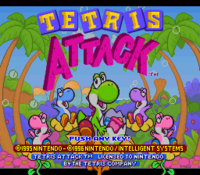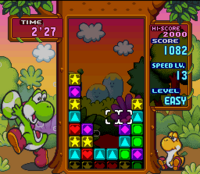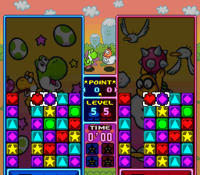Tetris Attack: Difference between revisions
m (→Gameplay) |
m (Reverted edits by SuperToad44onMarioWiki (talk) to last revision by MeritC) |
||
| Line 17: | Line 17: | ||
==Gameplay== | ==Gameplay== | ||
[[File:TA4.PNG|thumb|left|The title screen of the game.]] | [[File:TA4.PNG|thumb|left|The title screen of the game.]] | ||
The title of the game is misleading in that the gameplay is little like ''Tetris''. Instead, square panels rise from the bottom (called the "stack") and the job of the player is to line up three or more matching panels either horizontally or vertically as the stack rises. The player controls the panels using a rectangular cursor on the screen which the player uses to switch the selected panels back and forth. Extra points are given for combinations of more than three. If the stack touches the top of the playing field while rising, the game is over. | The title of the game is misleading in that the gameplay is little like ''Tetris''. Instead, square panels rise from the bottom (called the "stack") and the job of the player is to line up three or more matching panels either horizontally or vertically as the stack rises. The player controls the panels using a rectangular cursor on the screen which the player uses to switch the selected panels back and forth. Extra points are given for combinations of more than three. If the stack touches the top of the playing field while rising, the game is over. | ||
==Single Player Mode== | ==Single Player Mode== | ||
Revision as of 14:28, November 5, 2011
Template:Infobox Tetris Attack is a Super Nintendo Entertainment System and Game Boy puzzle game, based off the Japanese game Panel de Pon. Despite its name, Tetris Attack has no relation to the Tetris series and was later renamed Puzzle League when the sequels (such as Dr. Mario & Puzzle League) came out.
Gameplay
The title of the game is misleading in that the gameplay is little like Tetris. Instead, square panels rise from the bottom (called the "stack") and the job of the player is to line up three or more matching panels either horizontally or vertically as the stack rises. The player controls the panels using a rectangular cursor on the screen which the player uses to switch the selected panels back and forth. Extra points are given for combinations of more than three. If the stack touches the top of the playing field while rising, the game is over.
Single Player Mode
Endless
Endless mode is just that; players will be playing endlessly, trying to get the best possible score before they get a game over. Players can choose the difficulty level (Easy, Normal, Hard) and the speed level (lv. 1-99) to start out. However, the longer they manage to stay alive, the faster the stack will start to rise.
Time Trial
The time trial mode is also similar to the Endless mode, except players are given a time limit of two minutes, and the objective is to score as many points as possible before time is up.
Stage Clear
This mode is just like the Endless mode (see above), except players must clear all the panels above the "clear line" that's drawn in the stack. The line is not visible at the beginning of the game, and is only visible when players have cleared enough panels for the stack to rise enough. If the stack touches the top before all the panels above the "clear line" are removed, the players will lose. There's no time limit in this game mode.
There's a total of 30 rounds (not counting the "special stage" and "last stage"), with five rounds per level.
The "special stage" and "last stage" involve defeating Bowser with combos and chains before the stack reaches the very top. While the "special stage" is only a bonus stage to test the players' skills, the "last stage" can be repeated if they lose.
Puzzle
In the puzzle mode, players are given a number of panels on the screen, and they must clear all of them with only a limited number of switches by the cursor. Players play ten rounds with up to six different characters. Also, at the end of each round, players are given a password, which they can use to come back to their game at a later time. There is no time limit for this game mode.
On a side note, there are some even more difficult puzzles that players can play with if they have the proper password.
VS
Single player VS is a game where players can battle the computer in a fight. To free the players' allies from a spell cast by Kamek. One by one, the players and Yoshi must break the spell over each of their allies by battling and defeating them. The key to doing that is to dump garbage blocks, which resemble the Evil Ceiling from Wario's Woods, on their stack. Each battle gets successively more difficult, and as the players progress and free their allies, they can use them in battle as well.
Inside Mt. Wickedness, the players will face off against Hookbill the Koopa and Naval Piranha on all the skill levels. On the "Normal" and "Hard" skill levels, Kamek will be the next opponent. And on the "Hard" skill level, the players will face Bowser as the final opponent.
There's also a "Super Hard" skill level, which will heavily test the players' skills. All opponents fought on the "Hard" skill level will be in this skill level.
Characters
While Mario does not make a direct appearance in this game, Yoshi plays a starring role as an ally and a tutor to teach the player the game. A multitude of other characters from Yoshi's Island appear in the game as well, some as allies and some as enemies. The following characters are:
Pals
- Yoshi
- Lakitu
- Bumpty (SNES version only)
- Poochy
- Flying Wiggler
- Froggy
- Gargantua Blargg
- Lunge Fish
- Raphael the Raven
Note: Bumpty, Flying Wiggler, and Lunge Fish can only be used in the VS game modes. There is an exception in the Game Boy version of the Puzzle game mode.
Rivals
Note: All rival characters can only be used in the 2P Mode. There is an exception in the Game Boy version of the Puzzle game mode, however.
Other Release Formats
The Japanese version of Tetris Attack, titled 「ヨッシーのパネポン」 (Yoshi no Panepon) was released on the Satellaview. This version was a Japanese localization of the rebranded Panel De Pon with Yoshi characters. There was also an option in the menus to play the game with the characters and story dialogue in English, but the menus would stay in Japanese.
The Game Boy version was also released in Japan under the same name, as a standard GB ROM cartridge.
Secrets
Below are a list of secrets that can be found. None of them stay unlocked, however.
SNES
- Upon turning on the SNES, press the following buttons;
,
,
,
. If done correctly, the player will hear a chime. When the player does a one-player game mode, the stack will not stop, regardless of if the player does a combo or chain.
- In the 1P VS mode, the player can play the "Super Hard" skill level by pressing
,
, and
at the same time while the "Hard" skill level is selected. If done correctly, the lower background will turn dark red. The dark red background is a sign that the player is playing on the "Super Hard" skill level.
- Players can use the rival characters in the 2P game modes by doing the following; player 1 and player 2 must hold the
and
buttons at the same time while on the character select screen. If done right, the "? panels" will change into the rival characters.
Game Boy
Options
The SNES version of the game does feature an "Options" menu, which enables the player to change the language settings, listen to sound effects and background music, and even view data about the characters.
There's also a "CPU Switch" feature, in which player 1 and/or player 2 will be controlled by a CPU player. However, this feature can't be used to view game endings in the single player game modes; if attempted, the player will get a message stating that the CPU Switch must be turned off to view the ending.
Reception
The game was placed 17th in the 100th issue of Nintendo Power's "100 best Nintendo games of all time" in 1997.[1] Its average score on Gamerankings was about 90%[2].
Trivia
- A minigame from Mario Party 6, called Block Star, plays almost exactly like Tetris Attack.
- Lip's theme music can be heard during the game tutorials.
- A Japanese version of this rebranded title, Yoshi no Panepon (ヨッシーのパネポン lit. "Yoshi's Panepon"?).
References
| Game Boy games | |
|---|---|
| Super Mario franchise | Alleyway (1989) • Baseball (1989) • Super Mario Land (1989) • Golf (1989) • Dr. Mario (1990) • Super Mario Land 2: 6 Golden Coins (1992) • Donkey Kong (1994) • Mario's Picross (1995) • Picross 2 (1996) |
| Donkey Kong franchise | Donkey Kong (1994) • Donkey Kong Land (1995) • Donkey Kong Land 2 (1996) • Donkey Kong Land III (1997) |
| Yoshi franchise | Yoshi (1991) • Yoshi's Cookie (1992) • Tetris Attack (1996) |
| Wario franchise | Wario Land: Super Mario Land 3 (1994) • Wario Blast: Featuring Bomberman! (1994) • Wario Land II (1998) |
| Miscellaneous | Tetris (1989) • The Legend of Zelda: Link's Awakening (1993) • Game & Watch Gallery (1997) • Game & Watch Gallery 2 (1997) |



